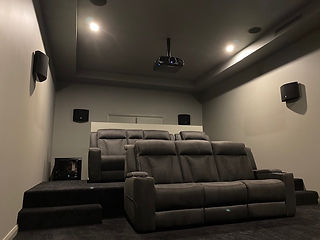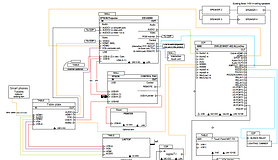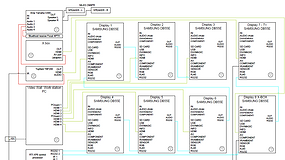we are only a phone call away
0402 652 665
CALL US NOW




Experience Movies@home
with our excellent
Home Cinema designs

Our Home Cinemas are designed under THX specifications to achieve the performance that movie directors intended.
We have a certified designer by THX, and a CEDIA certified Professional
200" Cinemascope screen Theatre System's A&V Designed by Juan Leon (while working for Len Wallis Audio) in Sydney
What does THX mean?
THX is a standard as well as a certification for high-fidelity audio/visual reproduction for cinemas, theatres, screening rooms, home theatres, consumer-grade and professional speakers, car audio systems as well as many others
What does CEDIA mean?
Custom Electronics Design and Installation Association
consists of trade companies from Australia and overseas who specialise in the installation processes of electronic systems in domestic homes.
HOME CINEMAS Designed by Hi-Fi Doctor in NEWCASTLE
ATMOS 7.2.1Home Cinema projection system
Projector EPSON TW9400 - Screen Technics 130" 2.35:1 aspect ratio for a cinematic experience with an ultra wide image, and 9 speaker system





ATMOS 5.2.2 Premium Home Cinema system
75" Samsung TV - MARANTZ Surround receiver -7 speaker system 3 front in-wall - 2 surround in-ceiling - 2 Atmos in-ceiling
2 subwoofers
Home Theatre Audio system designed by Hi-Fi Doctor in collaboration with KARANDONIS Building (www.karandonisbuilding.com.au).
Upon observing the provided pictures, it is evident that the room features highly reflective walls and ceiling. To address this acoustic challenge while maintaining the modern aesthetic, our home theatre designer opted for speakers with a D’Appolito configuration. Additionally, the in-ceiling speakers were equipped with an angled baffle to direct sound towards the seating area, enhancing intelligibility at the listening position. These design choices have successfully controlled room reflections while preserving the room's contemporary appearance.
Furthermore, both the in-ceiling and wall speakers are equipped with enclosed back-boxes, ensuring acoustic integrity and preventing sound leakage to adjoining rooms.
The D’Appolito speaker design also helps regulate the dispersion of the tweeter. By harnessing the sound emitted from the midrange drivers, the tweeter's output is contained, similar to how parallel surfaces control dispersion. While there may be variations in the design, such as using two same-sized woofer/midrange drivers covering slightly different frequency ranges, these are not considered true D’Appolito designs.
The outcome of this design approach is a consistent directivity across frequencies, which may not hold great significance for monitors with limited listening areas. However, in a typical room where a significant portion of the sound is reflected, the impact is quite remarkable.
It is worth emphasizing the importance of engaging an experienced Home Theatre system designer to achieve optimal results, as demonstrated in this project.
During the component selection process, meticulous calculations were conducted to determine the final loudness at the main listening location. Our in-house calculators, namely "Pick Sound Pressure Level to main listening location" and "Leon Home Cinema design calculator," were utilized for this purpose.
In this specific case, where the client sits 5.1 meters away from the front speakers, the system can deliver a maximum loudness peak of up to 98.1 dB. This calculation takes into account factors such as speaker efficiency, impedance, amplifier power, and distance. It is important to note that room size and acoustic properties were not considered in this particular calculation.



Hi-Fi Doctor few samples of technical wiring diagrams, and 2D & 3D drawings produced in-house



We specialise in producing professional, technical scaled drawings and wiring diagrams for builders, furniture makers, and other AV companies.
For inquiries
Please contact Juan at 0402 652 665.







Surround Sound Reproduced at Home as Cinema Experience
Had you ever teared up watching a very emotional film?
by Juan Leon
The cinema experience is virtual reality in action, recreating natural events happening around you by tricking your senses using several sonic and visual effects that will drag you into the middle of the action where you can live the experience.
Creating immersive multidimensional sound effects requires multiple sources of sound (channels) and technologies such as Dolby or DTS that will allow the professional audio mixers and designers to combine and accurately match audio to the visuals on screen.
Dolby Atmos offers true 3D sound using two new concepts in cinema sound: audio objects and overhead speakers. They have captured the enthusiasm and excitement of consumers, the film industry, manufactures of home theatres and professional cinemas.
In a home setting you may have speakers fixed in different surround configurations. For example, 7.1.4 three at the front (Left-Centre-Right), two lateral surround, two rear surround, one subwoofer and four overhead (in-ceiling) speakers.
Dolby Atmos software is able to locate ‘objects’ (sources of sound) of up to 128 distinct sound objects which can be routed up to 64 different speakers within the three-dimensional space of a professional cinema. Therefore, you would feel as though the action is happening all around you.
At home Dolby 5.1 and 7.1 create a two-dimensional circle of surround in same plane. Dolby Atmos 7.1.4 (or 7.1.2), creates a 3D effect by adding overhead speakers (extra 2 or 4).
Aside from all the above technical jargon, it would be interesting to explore how this sonic virtual reality, paired with images and the related film’s story would affect our emotions.
We know that what we’re watching is fiction, but I bet that at some moment you had teared up watching a very emotional film or ever had trouble sleeping after watching a scary movie.
For us human beings, it is natural to first believe rather than be sceptical, otherwise society wouldn’t function. We accept and believe that other motorists will follow the traffic rules, otherwise we wouldn’t step into our cars. Almost one in five Australians fall victim to online scams and so on because we want to believe in others.
The brain is a complex organ that researchers are still trying to decode, it may be tricked by the information obtained by our senses. In the case of emotional movies, it is stimulated to makes us feel empathy, so if you cry watching movies, it’s a good thing, you’re a good and compassionate person feeling empathy for others.



